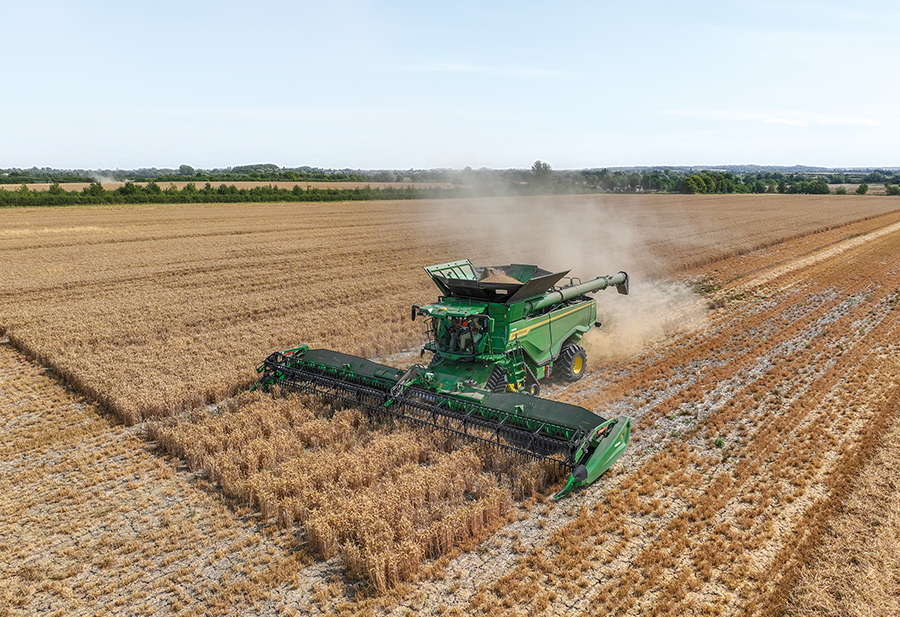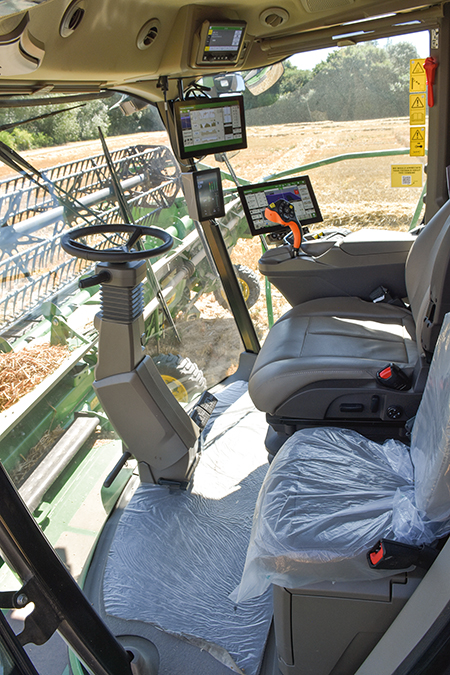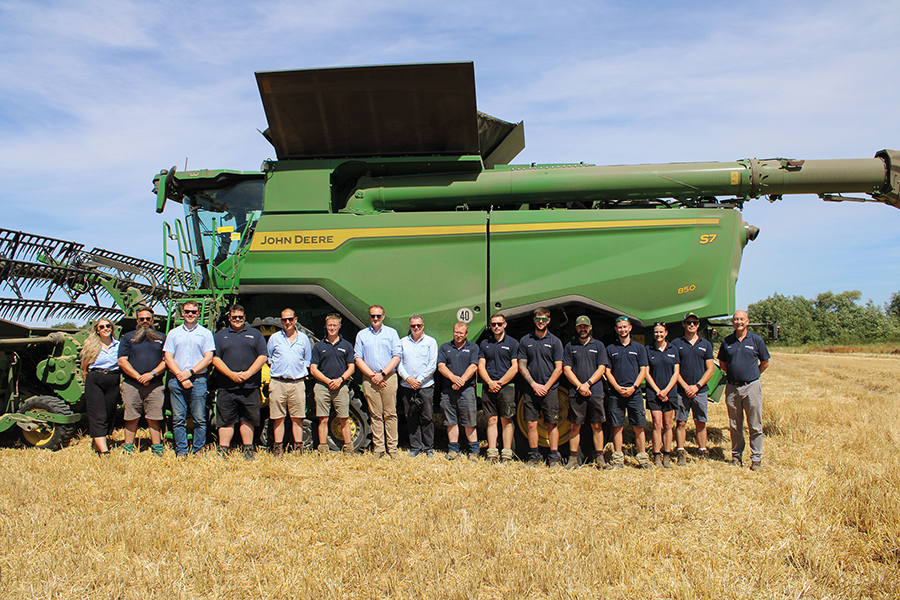New John Deere combines put through their paces at demo day
27th September 2024
Ben Burgess recently held a demonstration day at Trumpington Estate in Cambridgeshire, during which two new John Deere combines were put to the test. Neale Byart reports.

The S7-850 and the X9-1100 are two of John Deere’s latest combine models, incorporating the newest technology to ensure the operator gets the best from their harvest every time.
Welcoming guests to a recent open day, Ben Burgess harvesting manager, Paul Moss, explained: “We have two pre-production machines with the latest technology, software and electrical architecture and thought it would be a great opportunity to have a field day where customers could come along and see them in action, and discover what this new technology could do for them.”
Both the S7-850 and the X9-1100 working at the event were model year 2025 machines.
New technology suite
John Deere combine marketing for Europe, Jonathan Edwards, delved further into the specifications. “Both models have predictive ground speed automation and harvest settings automation which is the new technology suite for the X9 and S7.
“The Harvest Settings automation replaces the previous combine advisor suite which featured auto maintain, where the operator would set a performance target but which still required the skill set to make the necessary adjustments to ensure the combine achieved that target.

“However, with the Harvest Settings automation, you put in the acceptable limits that you are happy with, and the software will constantly adjust settings as required to ensure it stays within the target.”
The Predictive Ground Speed part of the technology uses cameras and biomass maps to work out the optimum harvesting speed based on crop density, and will speed up or slow down the combine as required to keep the results within the specified target.
It will still look at loss level variator or rotor pressure, as it has done historically, as well as other sensor information, header height and coverage map information, which tells it where it has already cut the crop.
The S7 800, S7 850 and S7 900 models feature the JD14X 14-litre engine from the X9 in the 547hp, 579hp and 625hp versions respectively, while the smallest model – the S7 700 – has the JD9X 9-litre engine producing 467hp.
The S7 range also has an updated residue management system and an increased unload rate of 150-litres per second, and can be equipped with the machine sync system for easier unloading. They can also have auto track turn automation and grain sensing.
“The new electronic architecture is the foundation for more automation and steps towards autonomy,” commented Jonathan. “If, for any reason, the cameras can’t see, then the system will revert to just using the biomass maps. But with the combine lights fitted to these models, the cameras will also work at night. They can see things such as down crop, which the biomass maps won’t detect, so they work most efficiently together, but can work independently, if required. The key aims of these new machines are increased productivity and efficiency.”
Hardware behind the tech
John Deere harvesting territory sales manager, Mike Baker, showed Farmers Guide the hardware behind the technology and talked in more detail about how it comes together to deliver better performance and an easier time for the operator.

“We have put a lot of focus into the new cab and technology, as well as the two new engines that you will find in the S7 models.
“The JD14X engine has been designed from the ground up, which has allowed us to simplify it and still meet emission standards. Getting an existing engine to meet new standards usually requires adding complex systems. We have been able to reduce the complexity in areas such as the exhaust after treatment system. We have also seen a huge increase in fuel efficiency over the older John Deere 13.5-litre engine that was in previous models. Another benefit of this is that the AdBlue usage is also reduced. The old 13.5-litre engine was designed to be Stage 2 compliant and had to be modified to bring it up to Stage 5.
“This latest engine has been designed from scratch as a Stage 5; so much of what we have learnt about emissions control has been built in from the start. This brings the added benefit of lower build prices, and increased reliability due to lower levels of complexity. It’s all about adding value in the right places and increasing efficiency.”
Operating at optimum efficiency
Mike explained that you could be the best combine driver in the country, but with all the other distractions – whether that’s calls from the farm manager, managing logistics or thinking about other jobs that need to be planned and carried out – even the most skilled operator pays a little bit less attention to the job in hand than they should, leaving the combine operating below its optimum efficiency.
“This is where our Harvest Settings automation and Predictive Ground Speed automation come into play,” he said.
There are cameras on the clean grain elevator and the return elevator to monitor the cleanliness of the grain and what type of material is going through the return, and also to monitor the losses from the back of the combine. This information is fed back to the machine, which will make automatic adjustments to ensure the pre-programmed parameters are being met at all times.
Mike continued: “Previously, if the sample was too dirty, or the losses were too high, it required a good skill level and lots of experience for the operator to know what changes to make to bring things back in line. Now it’s just a matter of dialling in an acceptable number and the technology will do the rest.”
The operator has four parameters to programme in: Engine power limit, lost grain limit, broken grain limit, and material other than grain. Obviously changing one, is likely to have a knock-on effect to the others but, with each limit set, the machine will adjust and keep things within the requirements. The key is to have the machine doing the least amount of work, and therefore using less fuel, for the maximum output.
“There is always an optimum performance level, and it is interesting to see the combine making the changes. Sometimes you will see a change in a particular parameter and think, ‘I’m not sure I would have done that’, but then you see the sample quality remaining high, or even getting better, and you realise that the technology works in ways that even a skilled operator would find hard to replicate,” commented Mike.
The predictive ground speed technology uses four forward facing cameras and biomass map satellite imagery to adjust the combine speed proactively, rather than reactively, according to the density of the crop ahead.
The S7 also has new rotary management, so the chopper design now matches the X series. This means that the knives are now dimpled for better airflow through the chopper, rather than the straight knives that created a vortex; and like a golf ball they cut through the air cleaner, meaning you get less straw moving through the chopper for a cleaner sample.
In the field
Farmers Guide took a ride in the X9 to see how the autonomous features work from the operator’s perspective. The cab is noticeably quiet. The seat swivels, is air controlled and offers a massaging function and, with air conditioning, the cab provides a comfortable place to work.
All screens, controls and switches are well placed and easy to operate with numerous rocker switches that can be customised for each operator’s preference.
The display allows easy setting of the limits for grain loss, cleanliness of the sample, broken grain and engine power limits with a graph for visual reference.
The software can be set up to be grain specific but also country and even region specific. As the software makes changes to the machine settings, the setting being adjusted changes colour so you can see exactly what the software is amending, as it happens.
The display will also show a predictive yield map and actual yields being achieved – on the day of the event, yields approached 100t per hour regularly.
You can feel the combine speed up and slow down as the crop ahead thins out or becomes denser.
The machine even sensed areas of black-grass and slowed down when it reached them. With an A/B line set, during the demo the operator had little to do apart from turning on the headlands, which can also be automated, and monitoring the levels in the grain tank.
The emptying process was very quick, going from a full 16,200 litres to empty in under two minutes.
At the end, the display will tell you how long you have worked, how many hectares harvested, how many are remaining if you haven’t finished, fuel usage, average throughput, average yield, and even how long you have left to finish the field, which Mike commented is surprisingly accurate. These figures can help with decision making on the farm in terms of working out why one field may yield better than another in terms of drilling time and weather, chemical application or any other variables you may have between fields.

“What you can’t do in farming is buy more time. You can only be as efficient as possible in the time available, and these systems achieve that.
“They are basically like your best machine operator, all of the time. And this all adds up to between 10 and 20%, sometimes even 30%, increase in performance, which is like getting an extra week of combining over a 200-hour season,” concluded Mike.
Specs
S7
- Models: 700, 800, 850, 900
- Engine: 9-litre in 700, 13.6-litre in other models
- Engine power: 467, 547, 579 and 625hp
- Grain tank: 14,100 or 10,600-litre
- Unloading rate: 150-litres per second
- Fuel tank capacity: 1,155-litre
- Unloading auger length: 6.9 or 8.7m
X9
- Models: 1000, 1100
- Engine: 13.6-litre
- Engine power: 630 and 690hp
- Grain tank: 14,800 and16,200-litre
- Unloading rate: 162 and 186 litres per second
- Fuel capacity: 1,250 litres
- Unloading auger length: 9.45m
Read more machinery news



